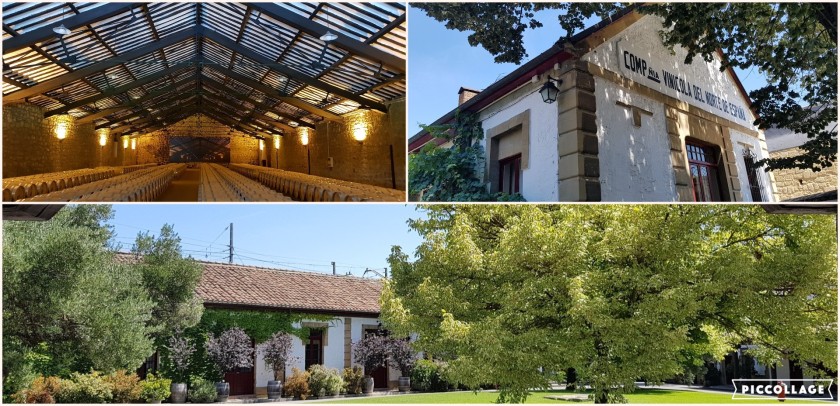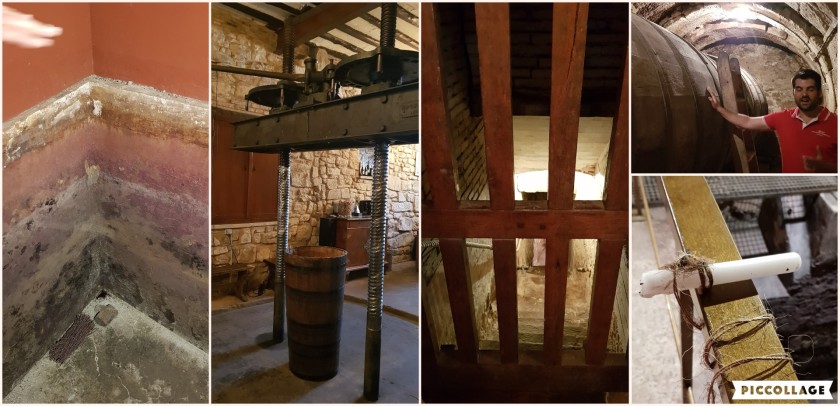A highlight of our time in Spain was our tour of La Rioja wineries with Rebeca and Robert of Rioja Like a Native. Over two days, we toured six diverse wineries, had two lovely lunches, gazed at the gorgeous Spanish countryside, and had a generally delightful time. Melissa had contacted Rebeca months ago with just the vaguest suggestion of what we would like to do, and somehow Rebeca managed to create the perfect plan, with a combination of old and new, small and large, family and corporate.
On our first day, we started with Bodegas Bohedal, and toured the facility with Leire. Her father is now the winemaker, while she is responsible for all inventory, purchasing, and sales. With a highly refined palate and winemakers on both sides of her family, we expect she’ll eventually take the winemaking reins. In the meantime, one of her responsibilities is showing tourists like us around the winery, telling us stories of generations of winemakers and offering us a unique tasting of a single vintage of tempranillo aged in three different oak barrels: French, Hungarian, and American. Much more difference than we’d imagined! And all delicious.
From there, we made our way to Haro, a small town that became a wine region hub when French grapes were destroyed by phylloxera and French winemakers came to practice their craft in Spain. Wineries clustered around the train station to make it easy to get the wine back to France. The town is full of these so-called centennial wineries. We stopped at CVNE (also called Cune due to a long-ago misreading of their name). Their barrel room was designed by Eiffel (yes, of the tower) and is a marvel in its own right. The wines were lovely – Melissa selected one to be her birthday wine this year.
Then we drove to the beautiful medieval town of LaGuardia. High on a hill with a protective wall, this carless town pulses with history and offers spectacular views of the countryside. After a lunch in a restaurant over a cave, we made our way to Bodegas Carlos San Pedro Perez de Viñaspre. There we met with a winemaker whose family has been growing grapes for 500 years in Rioja and who works in a winery over a 600 year old cave which has been used for storing wine for at least 300 years. Wow. It was a fascinating tour where we learned about joven wines which are made for drinking right in the coming year with minimal aging.
Exhausted from our day of touring (and drinking), we happily collapsed in our lovely room back in Logroño, reflecting on what a perfect combination of wineries we had seen that day. All so different, all so good.
The next morning, Rebeca and Robert picked us up and drove us to Bodegas Valentin Pascual in Cenicero. This family winery makes wine the same way it’s been done since the Romans first brought wine to Spain: carbonic maceration which ages the grapes in stone vats where they are then stomped (during what sounds like a great party!) so that the juice makes its way by gravity down to the giant barrels in the cellar. The ancient setting, the old equipment (including the candle that serves as a CO2 monitor), and the delightful energy of our guide (the son of the winemaker) made the whole thing so fun to see.
For a huge contrast, we went from there to Ysios, a large, modern winery that uses all of the latest techniques to create only Reserva wines. While we kind of wanted to prefer the traditional approach, we truly did love these newfangled wines. Had the price not reflected the high esteem in which they hold themselves, we would have seriously stocked up.
After all that tasting, we were ready for lunch. Rebeca and Robert took us to the most idyllic picnic table overlooking vineyards, in a rare shady spot. They laid out a wonderful lunch. It was perfect! While there, they gave us keychains that Robert had made for us of Rioja corks with copper Euro coin tops in recognition of our 7th anniversary. It was such a sweet gesture, and we will treasure them and the memories they bring up for us.
Satisfied from our tasty lunch, we headed for our final winery, Bodega Classica, perched on a high hill and looking like it’s always been there. Rebeca and Robert hadn’t been there before, and I think we were all a bit surprised to learn just how new it was. Bodega Classico was less than ten years old and was part of a huge wine organization that churns out 4 million bottles per year under a variety of labels. The woman giving the tour was lovely, though, and truly passionate about wine. And the wine itself was very good indeed.
Apart from the pleasure of visiting these wineries and seeing the beautiful countryside, it was also a delight to spend a couple days with Rebeca and Robert who made us feel at home, answered every question we had, and ensured that we enjoyed every moment of our time with them. We’re so very glad we chose Rioja Like a Native for our anniversary trip.
Tom’s quick side note: We loved Spanish wine in general. One thing that we loved about it was the price. One of the many bits of knowledge Rebeca and Robert laid on us was that wine is taxed as a food, not as alcohol, which keeps the price of amazing bottles of wine under five euros. Spanish wine comes in four main classifications: joven, which is very young, not aged in oak at all, and is ready to drink now; Crianza, aged two years, at least six months of which are in oak; Reserva, aged three years, one of which is in oak; and Gran Reserva, aged five years, 18 months in oak. The way we understand American classifications, Reserva just means the pick of the grapes. But then again, old old wine regions like La Rioja have very many rules to protect what it means to be a La Rioja wine.


Sounds like the perfect adventure for the two of you! So happy!
LikeLike